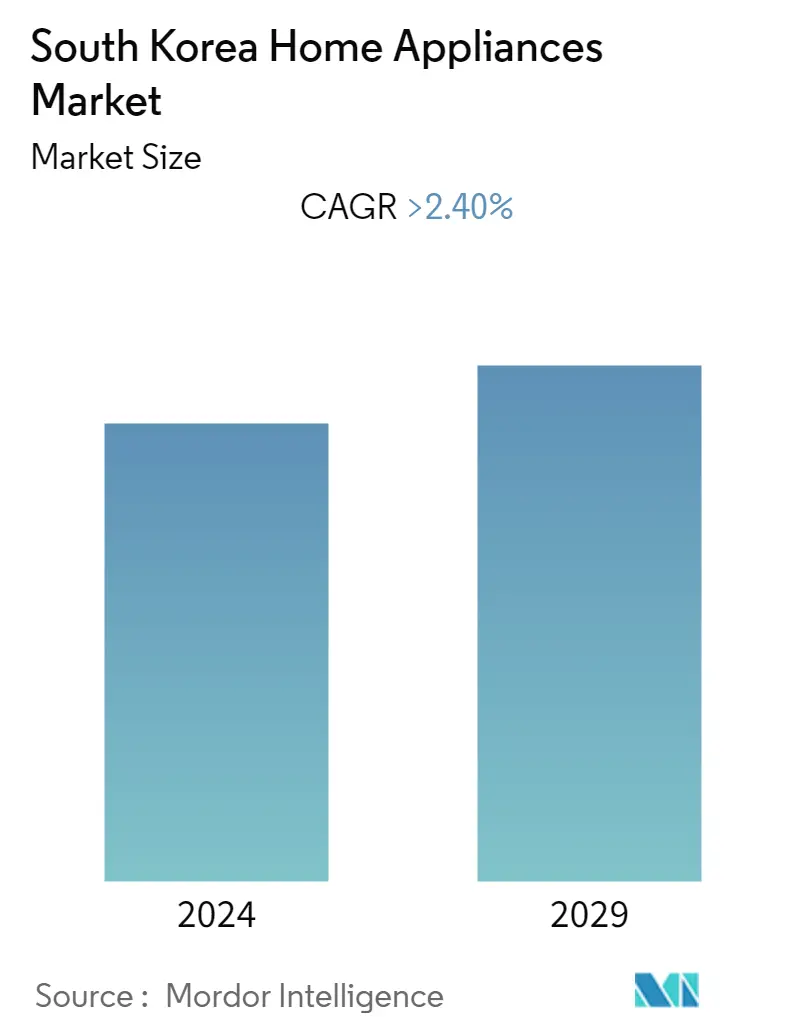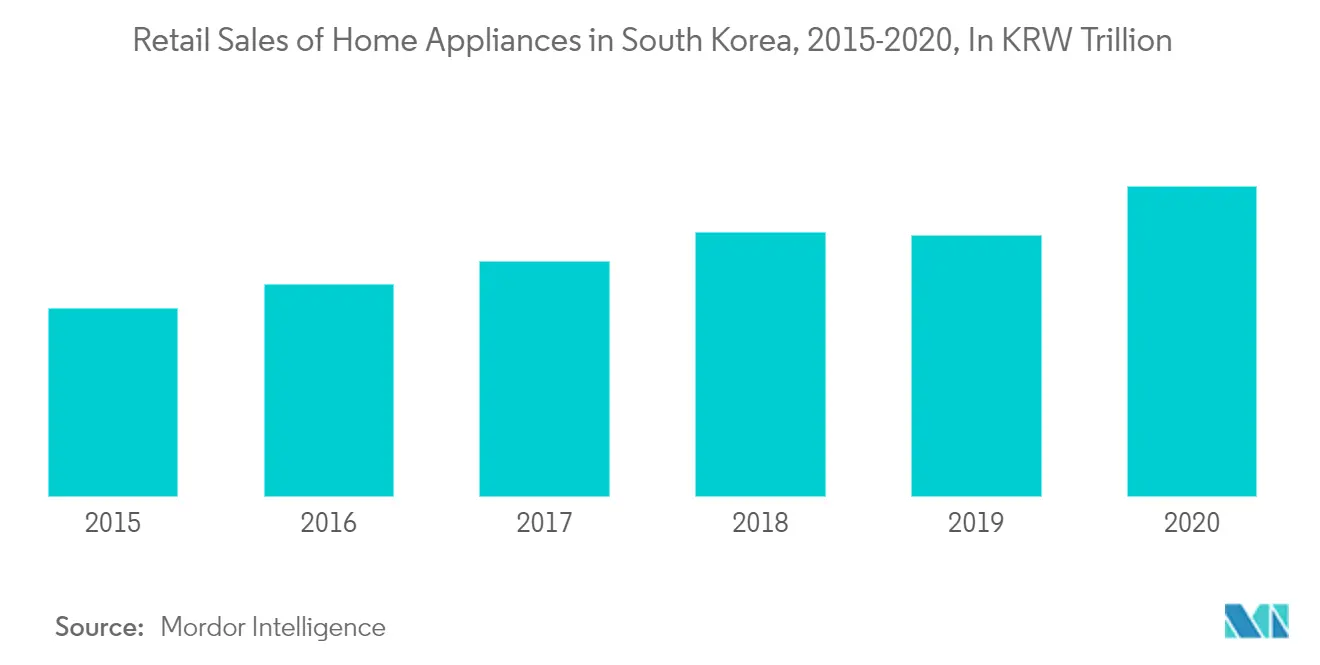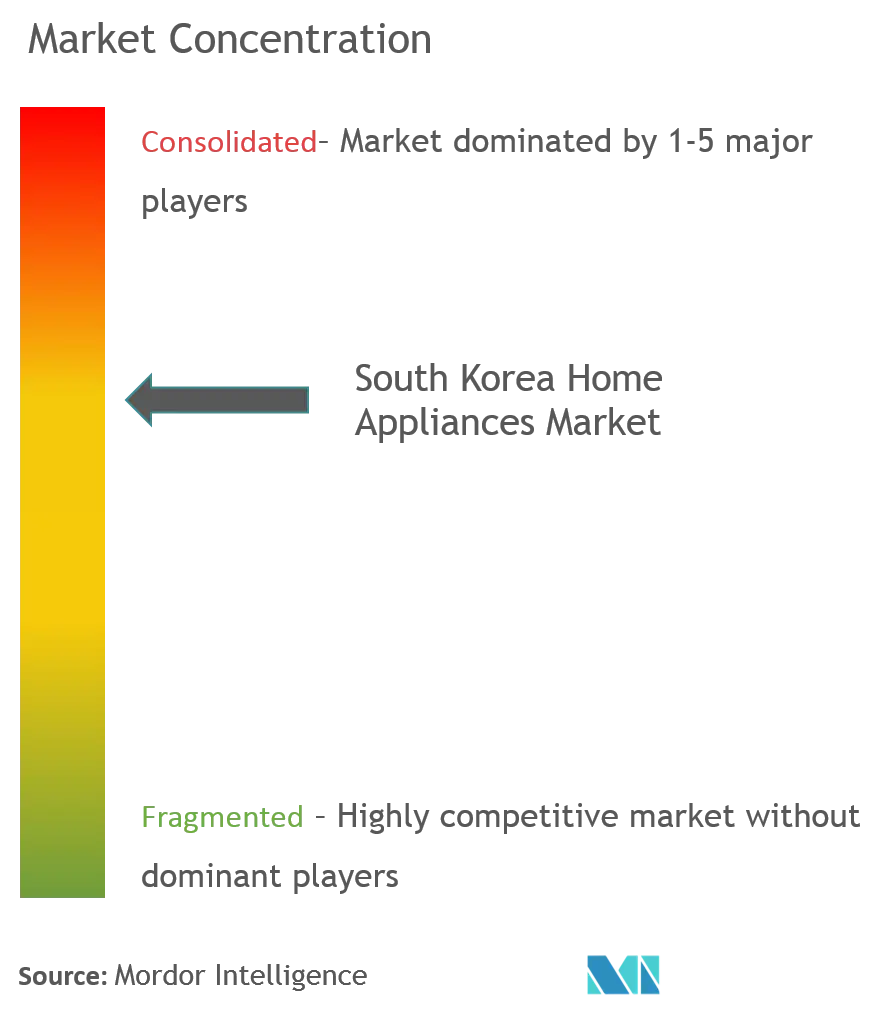South Korean Home Appliances Market Size

| Study Period | 2020 - 2029 |
| Base Year For Estimation | 2023 |
| Forecast Data Period | 2024 - 2029 |
| Historical Data Period | 2020 - 2022 |
| CAGR | 2.40 % |
Major Players.webp)
*Disclaimer: Major Players sorted in no particular order |
South Korean Home Appliances Market Analysis
A technology-driven country, South Korea, holds greater scope for the home appliances market. The majority of the existing technology innovations were first introduced in the South Korean market to match the dynamically changing consumer preferences. The electronics giants, like LG Electronics and Samsung, are retaining their global top positions by addressing these customer preferences in a timely manner. The market for major home appliances is greater than that of the small home appliances in this region. Technology up-gradation and the adoptability it holds for applications in every segment of the home appliance are making the market an evergreen one for manufacturers. Despite being a developed country with saturated market conditions, the South Korean home appliances market still holds the power to penetrate and grab a positive market share. This astronomical change that is being observed is due to the increased disposable incomes of people and the rapid urbanization trends that can be seen in different parts of the country. Large home appliances are still scoring a positive number when compared to small home appliances.
COVID-19 had a mixed impact on retail volume sales in the South Korean home appliances market in 2020, thus, significantly boosting the demand for coffee machines, coffee mills, and breadmakers. On the other hand, the pandemic may have a modest negative impact on the demand for light fryers and rice cookers.
South Korean Home Appliances Market Trends
This section covers the major market trends shaping the South Korea Home Appliances Market according to our research experts:
Technology and Innovation in Products are Driving the Market
Innovation in product development and the adoption of the latest technology, such as the Internet of Things (IoT) and artificial intelligence (AI), are driving the market. Being the fourth-largest economy in Asia, South Korean manufacturers never step back to invest more in innovation. The market for major home appliances is exhibiting a positive trend despite its existing presence rate in the market, owing to the factors like innovation that the manufacturers are focusing on while establishing their products. Smart homes concept, increasing popularity for built-in appliances within the construction channel, and AI and IoT functionalities on appliances connected through the internet are key elements that the customers are looking forward to. Diminishing levels of water reserves across the world are shaping the market for washing machines with low water utilization. LG Electronics created an app named Home Chat, which can be considered as a classic example to understand consumer requirements. This app assists its users in monitoring all home appliances like washing machines, refrigerators, and even appliances like cookers, anywhere through their smartphones. This connectivity helps the consumer to connect their appliances and monitor them in a timely manner.

Small Kitchen Appliances Sales are Generating Higher Revenue for the Small Appliances Segment
Sales of small kitchen appliances are increasing, owing to the fact that they reduce the time spent on the regular household activity. Understanding this, a majority number of manufacturers are trying to address the market requirements by understanding customer interest with innovations that simplify their lifestyle. Next to the small kitchen appliances, air purifiers are forecasted to grab a major share in the coming years, owing to the country's diminishing air quality and rising concerns about health complaints related to respiratory. Thus, climatic changes are also making way for more air purifiers to penetrate the market.

South Korean Home Appliances Industry Overview
The report covers major international players operating in the South Korean home appliances market. Multinational brands, such as LG Electronics and Samsung Electronics, are performing quite well in their home countries. LG Electronics tops the market with its quite promising sales volume, followed by Samsung Electronics. Both the companies are competing across major appliances categories and some small appliances categories.
South Korean Home Appliances Market Leaders
-
LG Electronics
-
Samsung Electronics
-
Whirlpool Corporation
-
Panasonic Corporation
-
Haier Electronics Group Co. Ltd,
*Disclaimer: Major Players sorted in no particular order

South Korean Home Appliances Market News
- July 2021 - LG Electronics (LG) and Magna International Inc. (Magna) signed the transaction agreement, establishing a joint venture between the two companies. The creation of the joint venture unifies Magna's strength in electric powertrain systems and world-class automotive manufacturing, with LG's expertise in component development for e-motors and inverters.
- July 2021 - Samsung Electronics and Q CELLS announced a new strategic partnership that will see the two companies combine their technological expertise to provide 'zero energy home' solutions. A zero energy home becomes energy self-sufficient by only utilizing energy that is drawn from the home itself. This self-sufficiency is achieved by both producing energies through renewables, like solar, and reducing energy consumption through the utilization of more efficient devices.
South Korean Home Appliances Market Report - Table of Contents
1. INTRODUCTION
- 1.1 Study Deliverables and Market Definition
- 1.2 Scope of the Study
2. RESEARCH METHODOLOGY
3. EXECUTIVE SUMMARY
4. MARKET INSIGHTS AND DYNAMICS
- 4.1 Market Overview
- 4.2 Market Drivers
- 4.3 Market Restraints
- 4.4 Value Chain Analysis
-
4.5 Porter's Five Forces Analysis
- 4.5.1 Threat of New Entrants
- 4.5.2 Bargaining Power of Buyers/Consumers
- 4.5.3 Bargaining Power of Suppliers
- 4.5.4 Threat of Substitute Products
- 4.5.5 Intensity of Competitive Rivalry
- 4.6 Technological Innovations
- 4.7 Impact of COVID-19 on the Market
5. MARKET SEGMENTATION
-
5.1 Major Appliances
- 5.1.1 Refrigerators
- 5.1.2 Freezers
- 5.1.3 Dishwashing Machines
- 5.1.4 Washing Machines
- 5.1.5 Cookers and Ovens
-
5.2 Small Appliances
- 5.2.1 Vacuum Cleaners
- 5.2.2 Toasters
- 5.2.3 Grills and Roasters
- 5.2.4 Coffee/Tea Makers
- 5.2.5 Mixers and Grinders
- 5.2.6 Other Appliances
-
5.3 Distribution Channel
- 5.3.1 Supermarkets and Hypermarkets
- 5.3.2 Specialty Stores
- 5.3.3 E-commerce
- 5.3.4 Other Distribution Channels
6. COMPETITIVE LANDSCAPE
- 6.1 Market Concentration Analysis
-
6.2 Company Profiles
- 6.2.1 Whirlpool Corporation
- 6.2.2 Electrolux AB
- 6.2.3 LG Electronics
- 6.2.4 Samsung Electronics
- 6.2.5 Panasonic Corporation
- 6.2.6 Haier Electronics Group Co. Ltd
- 6.2.7 BSH Hausgeräte GmbH
- 6.2.8 Arcelik AS
- 6.2.9 Gorenje Group
- 6.2.10 Mitsubishi Electric Corporation*
- *List Not Exhaustive
7. FUTURE OF THE MARKET
8. DISCLAIMER
** Subject To AvailablitySouth Korean Home Appliances Industry Segmentation
A complete background analysis of the South Korean home appliances industry, which includes an assessment of the industry associations, overall economy, and emerging market trends by segments, significant changes in the market dynamics, and market overview, is covered in the report.
| Major Appliances | Refrigerators |
| Freezers | |
| Dishwashing Machines | |
| Washing Machines | |
| Cookers and Ovens | |
| Small Appliances | Vacuum Cleaners |
| Toasters | |
| Grills and Roasters | |
| Coffee/Tea Makers | |
| Mixers and Grinders | |
| Other Appliances | |
| Distribution Channel | Supermarkets and Hypermarkets |
| Specialty Stores | |
| E-commerce | |
| Other Distribution Channels |
South Korean Home Appliances Market Research FAQs
What is the current South Korea Home Appliances Market size?
The South Korea Home Appliances Market is projected to register a CAGR of greater than 2.40% during the forecast period (2024-2029)
Who are the key players in South Korea Home Appliances Market?
LG Electronics, Samsung Electronics, Whirlpool Corporation, Panasonic Corporation and Haier Electronics Group Co. Ltd, are the major companies operating in the South Korea Home Appliances Market.
What years does this South Korea Home Appliances Market cover?
The report covers the South Korea Home Appliances Market historical market size for years: 2020, 2021, 2022 and 2023. The report also forecasts the South Korea Home Appliances Market size for years: 2024, 2025, 2026, 2027, 2028 and 2029.
South Korean Home Appliances Industry Report
Statistics for the 2024 South Korean Home Appliances market share, size and revenue growth rate, created by Mordor Intelligence™ Industry Reports. South Korean Home Appliances analysis includes a market forecast outlook to 2029 and historical overview. Get a sample of this industry analysis as a free report PDF download.



